Zari Thread Dori, a luminary in embroidery, stands as a testament to the fusion of artistry and tradition.
This specialized metallic thread, born from the meticulous intertwining of cotton or silk yarn with fine metallic wire, emanates a captivating sheen, defining opulence in textile embellishment.
Renowned for its non-elastic nature, it takes center stage in traditional embroidery styles like Zardosi and Aari, weaving intricate narratives on fabrics.
This introduction invites exploration into the world of Zari Thread Dori, where each strand encapsulates cultural richness, adding an unparalleled brilliance to ceremonial attire, borders, and embellishments, perpetuating the legacy of timeless craftsmanship.
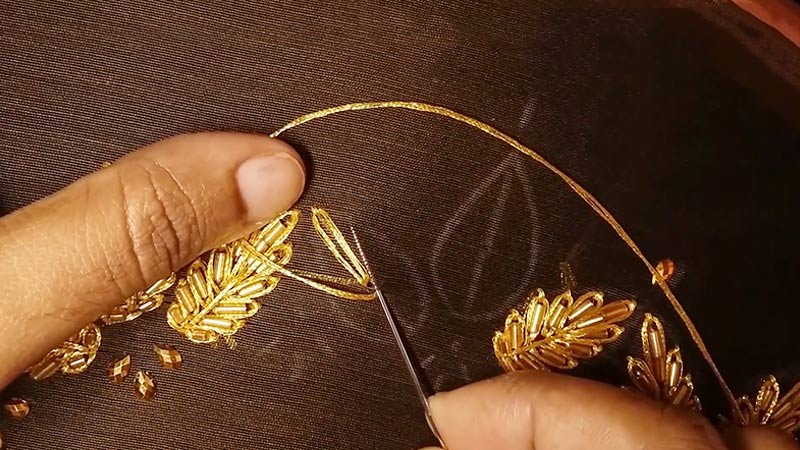
What Is Zari Thread Dori for Embroidery?
Zari Thread Dori for embroidery is a specialized metallic thread used in traditional textile embellishment. Crafted by wrapping a cotton or silk yarn core with fine metallic wire, it imparts a distinctive, shiny, and reflective appearance.
This non-elastic thread is a key element in traditional embroidery styles like Zardosi and Aari, creating intricate patterns and fabric designs.
Known for its opulent metallic sheen, Zari Thread Dori adds a touch of glamour to special occasion attire, borders, motifs, and embellishments. Its versatility extends to jewelry making, contributing to the richness of cultural heritage and contemporary design.
Characteristics of Zari Thread Dori in Embroidery
Zari thread dori possesses several key characteristics that make it distinct and highly valued in embroidery.
Here are the primary features:
Metallic Sheen
The most defining characteristic of Zari thread dori is its metallic appearance. The thread exhibits a shiny, reflective sheen that imparts a luxurious and decorative quality to embroidered designs. This metallic luster adds opulence and richness to the overall aesthetic.
Non-Elastic Nature
Zari thread dori is non-elastic, meaning it lacks stretchiness. This non-elastic quality contributes to the stability and strength of the embroidery, ensuring that the intricate patterns and designs maintain their shape and durability over time.
Strength and Durability
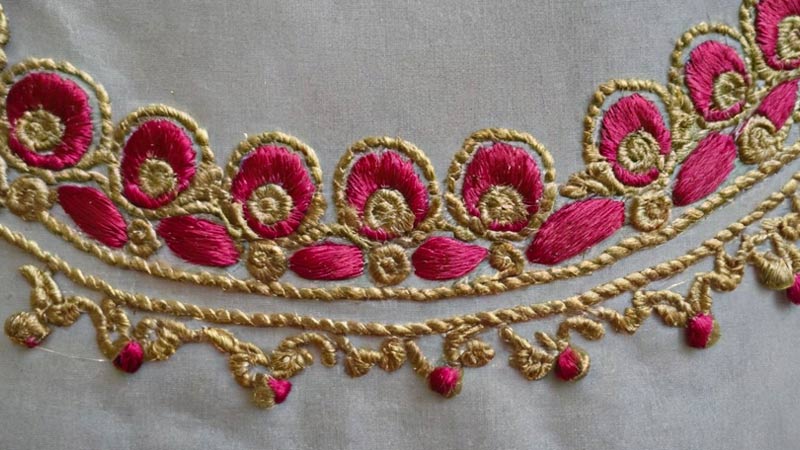
Due to its construction, with a core of cotton or silk yarn wrapped in metallic wire, Zari thread Dori is known for its strength. This makes it suitable for detailed and intricate embroidery work where durability is essential.
Versatility
Zari thread Dori is versatile and can be applied to various fabrics, including silk, satin, and other traditional textiles. Its adaptability makes it suitable for embellishing various garments, accessories, and home decor items.
Intricate Detailing
Zari thread allows for intricate detailing in embroidery. Craftsmen can create fine lines, delicate patterns, and elaborate designs, making it particularly well-suited for traditional embroidery techniques like Zardosi, Kantha, and Aari work.
Cultural and Traditional Significance
Zari’s work has deep cultural and traditional significance, especially in South Asian countries. It is often associated with special occasions, ceremonies, and traditional attire, reflecting the rich heritage of craftsmanship.
Special Occasion Use
Zari thread dori is commonly used in garments and textiles for special occasions, such as weddings, festivals, and celebratory events. Its use adds a sense of grandeur and festivity to the attire.
Jewelry Making
Apart from embroidery, Zari thread dori is also utilized in jewelry making. It can be woven into intricate patterns to create ornate jewelry pieces, providing a metallic touch to accessories.
How Is Zari Thread Dori Used in Embroidery?
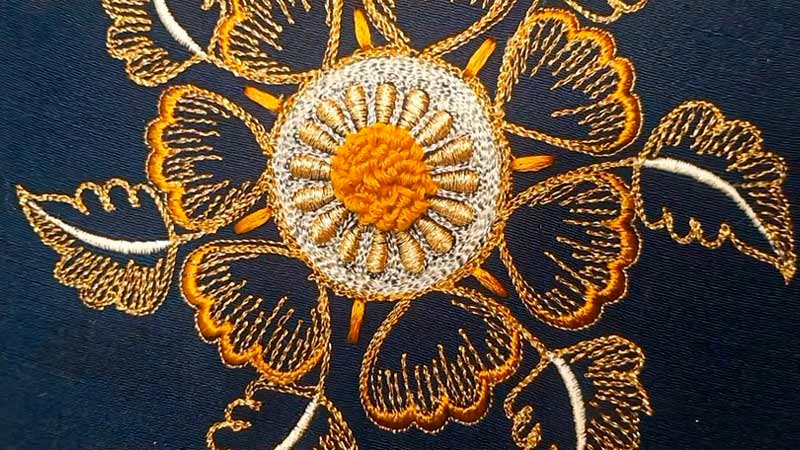
Zari thread dori is a versatile and decorative material widely used in various forms of embroidery. Its application enhances the visual appeal of fabrics by adding a touch of opulence and sophistication.
Here’s how Zari thread Dori is commonly used in embroidery:
Traditional Embroidery Techniques
- Zardosi Embroidery: Zari thread dori is a key element in Zardosi, an intricate and traditional form of embroidery. It involves creating elaborate patterns and designs using metallic threads, beads, and sequins, often used in bridal and festive wear.
- Aari Work: Aari embroidery employs a hooked needle to create fine chain stitches, and Zari thread Dori is frequently used to outline and fill in intricate designs on fabrics.
Borders and Edges
Zari thread Dori is used to create borders and edges on various garments. The metallic sheen and intricate detailing add a decorative element to the hems of sarees, dupattas, and other traditional attire.
Intricate Patterns and Motifs
Craftsmen use Zari thread dori to create intricate patterns and motifs on fabrics. This can include floral designs, paisleys, and other detailed elements that contribute to the richness of the embroidery.
Embellishments
Zari thread dori is often employed as an embellishment to enhance the overall design. It may outline shapes, add accents, or create focal points within the embroidery, providing a sense of luxury.
Textile Embellishment
Silk, satin, and velvet fabrics are frequently embellished with Zari thread dori to elevate their aesthetic. The metallic sheen contrasts beautifully with the fabric, making it suitable for casual and formal wear.
Special Occasion Attire
Zari thread dori is extensively used in embroidering special occasion attire, especially for weddings and festive events. Bridal lehengas, sarees, and other ceremonial garments often feature elaborate Zari work to signify grandeur and celebration.
Jewelry Making
Apart from fabric embroidery, Zari thread dori finds application in jewelry making. It is woven into intricate patterns to create necklaces, bracelets, and other accessories, providing a metallic touch to adornments.
DIY and Craft Projects
Enthusiasts often incorporate Zari thread dori into DIY and craft projects. Its versatility makes it suitable for various creative endeavors, including embellishing home decor items, accessories, and handmade gifts.
How Is Zari Thread Dori Crafted for Embroidery?
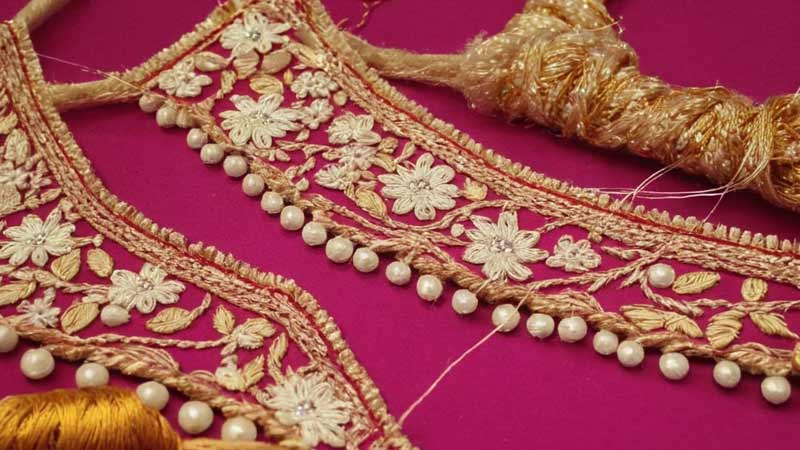
The crafting of Zari Thread Dori for embroidery involves a meticulous process that combines traditional craftsmanship with modern techniques.
Here’s an overview of how Zari Thread Dori is typically crafted:
Selection of Core Material
The process begins with selecting a core material, cotton or silk yarn. This core provides the structure and foundation for the thread.
Metallic Wrapping
The selected core material is then wrapped with fine metallic wire. This wrapping can be done using materials such as copper or brass. The wrapping creates the metallic outer layer of the thread.
Twisting and Coiling
The wrapped core is often twisted or coiled to give the thread its desired texture and appearance. This step contributes to the strength and flexibility of the final Zari Thread Dori.
Electroplating (Optional)
In some cases, the metallic-coated thread may undergo an electroplating process. This involves depositing a thin layer of precious metals, such as gold or silver, onto the surface of the metallic coating.
Electroplating enhances the shine and durability of the thread, creating a more luxurious finish.
Cutting and Finishing
Once the wrapping, twisting, and electroplating processes are complete, the Zari Thread Dori is cut to the desired length. The ends may be sealed or finished to prevent unraveling.
Quality Control
Quality control measures are implemented throughout the crafting process to ensure that the Zari Thread Dori meets certain standards. This includes checking for uniformity, strength, and the desired metallic sheen.
Packaging
The finished Zari Thread Dori is then packaged and made ready for distribution. The packaging may include information about the type of thread, its composition, and any specific care instructions.
Types of Embroidery Styles Commonly Use Zari Thread Dori
Zari Thread Dori is a versatile material applied in various embroidery styles, especially in traditional and cultural contexts.
Here are some common embroidery styles where Zari Thread Dori is frequently used:
Zardosi Embroidery
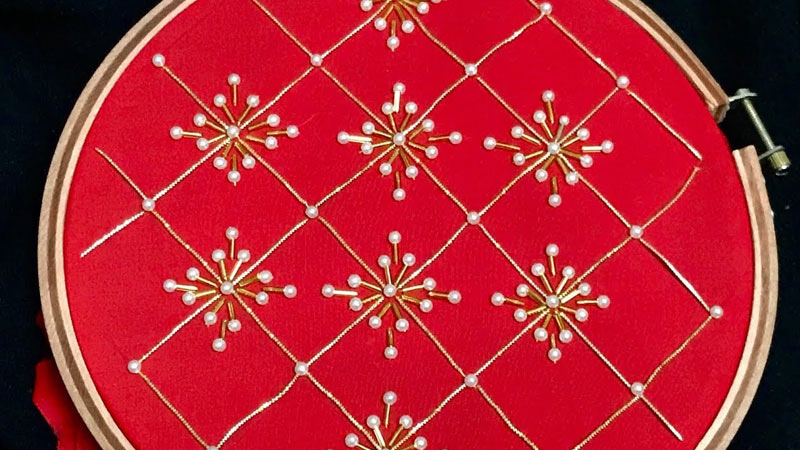
Zardosi is an elaborate and opulent embroidery style originating from India. It involves using metallic threads, including Zari Thread Dori, beads, sequins, and sometimes real gems.
Zardosi often creates intricate patterns on bridal wear, royal garments, and festive attire.
Aari Work
Aari embroidery is a traditional Indian needlework technique where a hooked needle, known as an “Aari” or “Magar,” is used to create fine chain stitches.
Zari Thread Dori is commonly used in Aari work to outline and fill in intricate fabric designs, such as sarees and dupattas.
Kantha Embroidery
Kantha is a traditional embroidery style from the Indian subcontinent, particularly from the Bengal region. It involves simple running stitches in various patterns to create beautiful designs.
Zari Thread Dori is sometimes used to add a touch of metallic embellishment to Kantha embroidery.
Banjara Embroidery
Banjara embroidery is an ethnic and vibrant style practiced by the Banjara community in India. Zari Thread Dori is often incorporated to create bold and colorful designs on fabrics, such as in the embellishment of Banjara textiles and accessories.
Kasuti Embroidery
Kasuti is a traditional form of embroidery from Karnataka, India. Zari Thread Dori is used along with contrasting colored threads to create intricate geometric patterns. Kasuti is known for its precision and is often seen on sarees and other garments.
Chikankari Embroidery
Chikankari is a delicate and intricate embroidery originating from Lucknow, India. While primarily using white thread on white fabric, Zari Thread Dori is sometimes introduced to add a subtle metallic sheen to the designs.
Phulkari Embroidery
Phulkari is a traditional embroidery style from the Punjab region. Zari Thread Dori is occasionally used to embellish the vibrant and floral patterns created through long and short stitches. It is often seen on dupattas and shawls.
Baluchari Sari Embroidery
Baluchari saris from West Bengal, India, feature intricate depictions of mythological scenes. Zari Thread Dori is commonly used to highlight the details in these elaborate designs.
FAQs
Is Zari Thread Dori suitable for machine embroidery?
While traditionally used in hand embroidery, some types of Zari Thread Dori are designed for machine embroidery, offering flexibility in application.
What is the ideal needle size for embroidering with Zari Thread Dori?
Using a fine embroidery needle is recommended to prevent damage to the delicate metallic threads of Zari Thread Dori.
How does Zari Thread Dori contribute to the cultural significance of embroidery?
Zari Thread Dori is vital in preserving cultural heritage, symbolizing tradition and richness in textile art.
Can Zari Thread Dori be used for free-motion embroidery?
Yes, Zari Thread Dori can be used for free-motion embroidery, allowing for creative and intricate designs with greater flexibility.
What fabrics pair well with Zari Thread Dori in embroidery?
Zari Thread Dori complements silk, satin, and velvet fabrics, enhancing their aesthetic appeal.
To Recap
Zari Thread Dori is an irreplaceable luminary in the exquisite embroidery tapestry, weaving a story of tradition, craftsmanship, and timeless elegance.
Its unique metallic allure, meticulously crafted by intertwining cotton or silk with fine metallic wire, transcends mere threads; it embodies cultural heritage.
From adorning special occasion attire to embellishing borders and motifs, Zari Thread Dori adds a touch of opulence to every stitch.
As we unravel the final threads of this narrative, the conclusion is not just a culmination but an invitation to appreciate the enduring legacy of Zari. This thread connects the past with the present, perpetuating the artistry and grandeur of textile embellishment across generations.
Leave a Reply